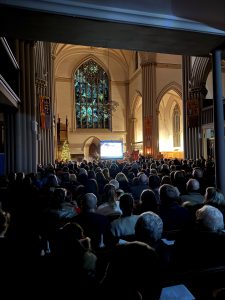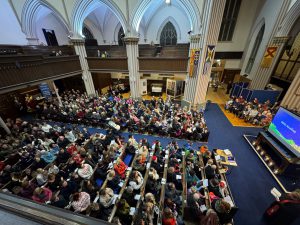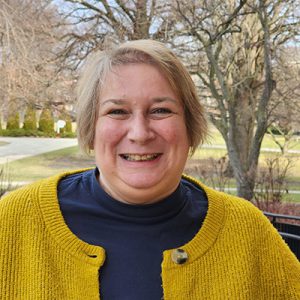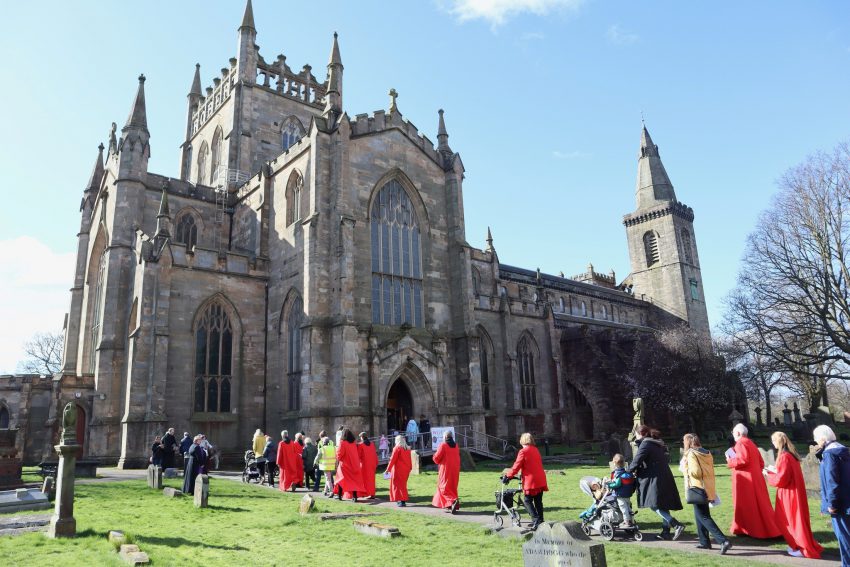At Pittsburgh Seminary, we seek to participate in God’s ongoing mission in the world by seeing and getting to know people as our neighbors. Challenged by Jesus’ parable of the Good Samaritan and inspired by Mr. Fred Rogers ’62, who sang, “I have always wanted to have a neighbor just like you!”, I am writing this blog to introduce you to some of my neighbors—students in our Doctor of Ministry (D.Min.) Program, for which I am honored to serve as the director.
I would like to introduce you to my neighbor MaryAnn Rennie, who was ordained in the Church of Scotland in 1998 and has been the minister of the Abbey Church of Dunfermline (Dunfermline Abbey) since 2012. She is originally from Edinburgh, Scotland, and she completed her studies at the University of Edinburgh, including: batchelor of divinity (honours) in 1994, masters of theology (in ministry) in 1995, and postgraduate certificate in pastoral care and counselling in 1996. In 2024, she graduated from Pittsburgh Theological Seminary with her doctor of ministry degree (Reformed cohort). Her final project was, “Discovering Abbey-Style Mission: Exploring the Potential of Cathedral Style Mission within a Scottish Reformed Context.” She is married and has two adult children.
–The Rev. Dr. Donna Giver-Johnston, Director of the Doctor of Ministry Program at Pittsburgh Theological Seminary
A Place of Welcome
Those approaching Dunfermline Abbey would be forgiven for thinking that our nearest neighbours are the gravestones that surround the building on almost every side. However, the graveyard is very much like the promise of the resurrection because it provides a place to encounter life. It is the place where the congregation of the Abbey Church of Dunfermline often meet the diverse groups of people who are our neighbours.
Like other Church of Scotland congregations, the Abbey Church of Dunfermline is a parish church, and so much of church life is shaped by living Christian faith within the community. A stained-glass window in the side chapel uses Matthew 25: 25-40 and acts as a focus for mission as we hope to offer a place of refuge and a place of hope. In serving our local community, our church groups reflect friendship and support, with focused groups for those who are bereaved or who live with dementia.
The building and congregation are a reassuring presence to local neighbours, who particularly value the Christian seasons. Advent, Christmas, and Easter are busy, vibrant celebrations of local people gathering together in Christ’s name.
 Our local neighbours also include civic, ecumenical, and faith communities. One Dunfermline Abbey elder says about our worshiping life, “. . . there [are] two levels that we . . . do. These big special services because of the building we’re in, but that kind of regular worship [that] just happens in the same way that it happens for anyone . . . anywhere else.” The building inspires a congregation to be hospitable and offers a place to welcome civic services and activities, including children and charities invited to celebrate their role in the local community, art exhibitions that reflect the church life or engaging with faith, community concerts, interfaith celebrations of the National Health Service, ecumenical markings of shared faith in the St. Margaret agreement, and the King and Queen on their first royal engagement following the accession.
Our local neighbours also include civic, ecumenical, and faith communities. One Dunfermline Abbey elder says about our worshiping life, “. . . there [are] two levels that we . . . do. These big special services because of the building we’re in, but that kind of regular worship [that] just happens in the same way that it happens for anyone . . . anywhere else.” The building inspires a congregation to be hospitable and offers a place to welcome civic services and activities, including children and charities invited to celebrate their role in the local community, art exhibitions that reflect the church life or engaging with faith, community concerts, interfaith celebrations of the National Health Service, ecumenical markings of shared faith in the St. Margaret agreement, and the King and Queen on their first royal engagement following the accession.
A Place of History
Understanding the history of our building and our community reveals the diversity of our neighbours, who are local and global, ecumenical, civic, and interfaith.
A Christian community existed in Dunfermline prior to St. Margaret of Scotland’s marriage to King Malcolm Canmore in 1070, but it is she who is credited with the establishment of a church in Dunfermline. Her son, David I, raised the church to an Abbey in 1128. Robert the Bruce was a regular visitor to Dunfermline Abbey. In 1320, he funded the completion and upgrading of the monastery and guesthouses, and he was buried there in 1329.

During the Scottish Reformation of 1560, Dunfermline Abbey was ransacked, with the east end of the choir area abandoned, and eventually destroyed when the central tower collapsed in high winds in the 18th century. The Protestant congregation continued to use the nave for worship until 1821, when the ‘new’ church was built on the site of the former choir to accommodate a growing congregation. During the clearing of the ground for the new build, the bones of Robert the Bruce were rediscovered. This led to redesign of the church to accommodate the grave, which sits below the pulpit, and a magnificent tower which has become synonymous with Dunfermline. While the Scottish king is celebrated within the church, what is left of St. Margaret’s Shrine is outside the church, behind the vestry. Local historians question whether it was left outside so as not to upset Presbyterian sensitivities or to allow access for the Roman Catholic community who were visiting the site.
A Place for the Community
The history of the site highlights two other groups of neighbours. More than 40,000 visitors are welcomed by our partners on the site. Prior to the COVID pandemic, the congregation employed summer custodians, and volunteers ran a gift shop within the church, which was open from April to October. In 2022, there was an opportunity to work more closely with Historic Environment Scotland. The congregation continues to offer a summer custodian, and the building is now open almost every day throughout the year. It has been an opportunity to value the expertise and skills of others, while offering support with volunteers who like to share the history and faith of the church community.

The Abbey elders are firmly grounded in their mission to our local neighbours, with one saying, “we’re just an ordinary parish church . . . no different from any other church in the town.” They also recognise that “people see the church, the Abbey as a focal point for . . . things that happen.” The focal point draws the gaze (or even glance) of the devout and the unknown seeker, offering a place to encounter the grace of God and freedom to allow God’s Spirit to inspire faith and mission.
 The Rev. Dr. MaryAnn Rennie ’24 has been the minister of the Abbey Church of Dunfermline (Dunfermline Abbey) since 2012. Originally from Edinburgh, Scotland, she completed studies at the University of Edinburgh, including: batchelor of divinity (honours), masters of theology (in ministry), and a postgraduate certificate in pastoral care and counselling. She also holds a doctor of ministry from Pittsburgh Theological Seminary (Reformed focus). She is ordained in the Church of Scotland.
The Rev. Dr. MaryAnn Rennie ’24 has been the minister of the Abbey Church of Dunfermline (Dunfermline Abbey) since 2012. Originally from Edinburgh, Scotland, she completed studies at the University of Edinburgh, including: batchelor of divinity (honours), masters of theology (in ministry), and a postgraduate certificate in pastoral care and counselling. She also holds a doctor of ministry from Pittsburgh Theological Seminary (Reformed focus). She is ordained in the Church of Scotland.
Read Next



